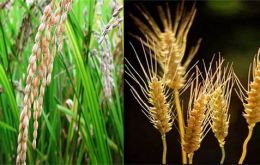MercoPress. South Atlantic News Agency
Tag: food commodities
-
Sunday, October 10th 2021 - 19:30 UTC
World food prices rose 1,2% in September and 32,8% year to year, FAO

World food commodity prices rose in September, led by tightening supply conditions and robust demand for staples such as wheat and palm oil, the Food and Agriculture Organization of the United Nations (FAO) reported. FAO's Food Price Index averaged 130.0 points in September, up 1.2% from August and 32.8% higher than in September 2020. The index tracks monthly changes in the international prices of commonly traded food commodities.
-
Saturday, November 9th 2013 - 17:55 UTC
Food commodity markets more balances and less price volatile, says FAO

Food commodity markets are becoming more balanced and less price volatile than in recent years thanks to improved supplies and a recovery in global inventories of cereals, according to FAO's Food Outlook report published on Friday.
-
Friday, June 14th 2013 - 08:16 UTC
Food commodity markets more balanced in 2013/14, says FAO Outlook

Food commodity markets, in particular for cereals, are set to be more balanced in 2013/14, according to FAO Food Outlook report published on Thursday. World food imports in 2013 are tentatively forecast at 1.09 trillion dollars, close to last year's level, but 13% below the record of 2011, the biannual report on global food markets said.
-
Thursday, October 4th 2012 - 19:52 UTC
FAO Prices Index up 1.4% in September pushed by dairy and meats

Following two months of stability, the FAO Price Index rose slightly in September 2012, up 1.4%, or 3 points, from its level in August. The Index, based on the prices of a basket of internationally traded food commodities, climbed to 216 points in September from 213 points in August.
-
Wednesday, July 11th 2012 - 22:09 UTC
OECD/FAO anticipate promising future for farm-commodity prices

World farm commodity prices will edge higher in the next decade, and oilseeds are set to outperform wheat and other cereals, both trends fuelled by demand in emerging economies, the OECD said on Wednesday, presenting a joint report with the UN's food agency FAO.
